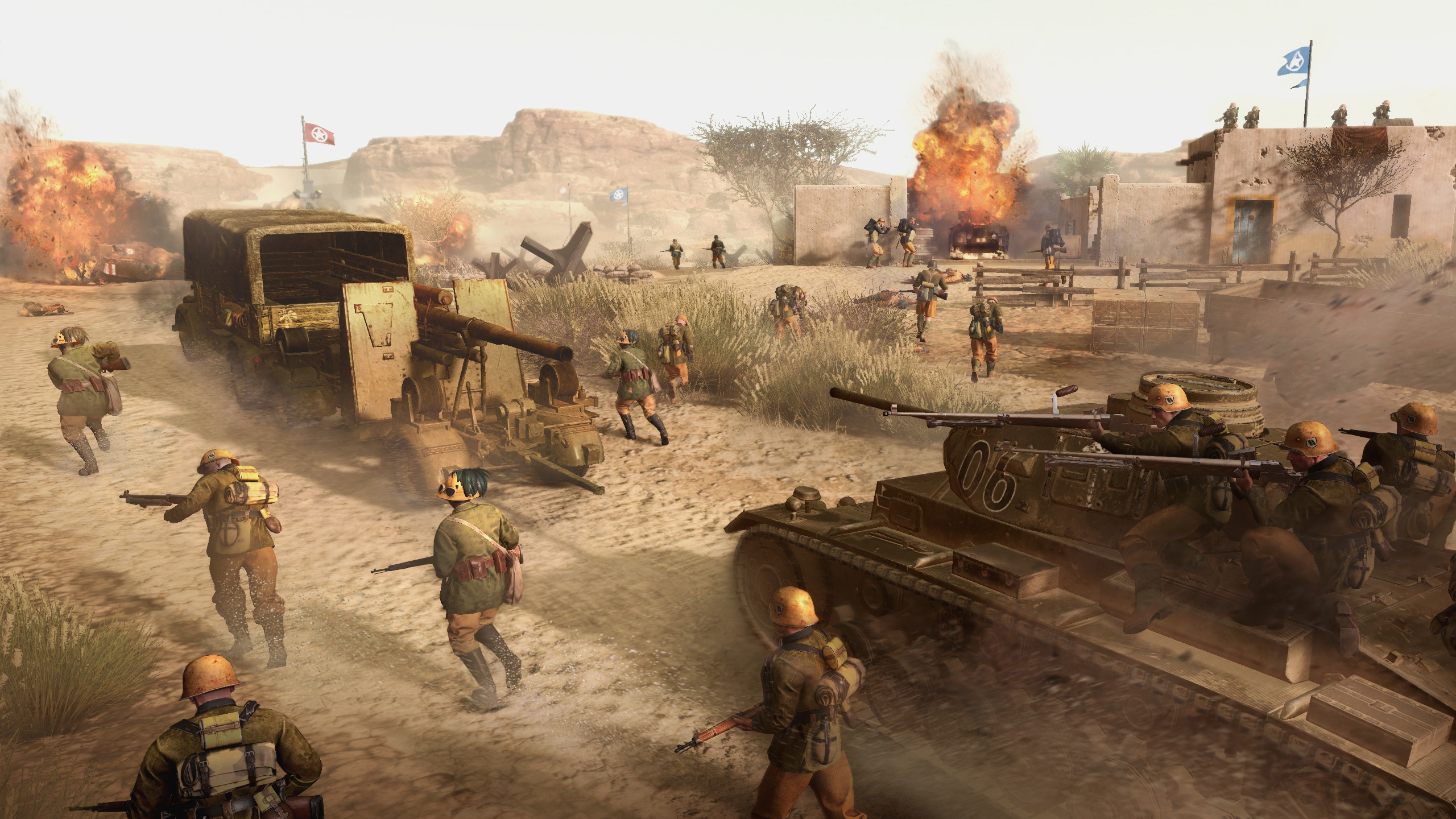We can safely say that Company of Heroes 3 is one of the most anticipated RTS of 2023, especially for fans of WWII inspired games. Relic Entertainment made gaming history with the first Company of Heroes in 2006 and has recently been overshadowed by the revival of another classic RTS, Age of Empires IV. It’s true that I was a bit disappointed with the work of this last game, but my experience with Company of Heroes for this review is very positive.
While the first two Company of Heroes took place respectively on the western front after the Normandy landings and on the eastern front of WWII, Company of Heroes 3 deals with the North African and Italian fronts between about 1942 and 1944. . The four playable fronts represent the forces involved in this conflict: US forces, British forces, the German Wehrmacht and the German Afrika Korps. Other nations that have historically been involved are represented in other ways: the British can also rely on Commonwealth troops, including Gurkhas and Indian forces, while the Afrika Korps faction can call in support from elite Italian units and armor.
The game features a traditional single player campaign where you play as a side of the Afrika Korps, but one of the major new features of this game is the new “dynamic” single player campaign. Playing as allies, the dynamic campaign map lets you move units and conquer settlements in a turn-based campaign map similar to Total War games. When a fight starts, you can resolve it automatically or fight it yourself in a classic real-time battle. It’s evident that Relic has put a lot of effort into making the gameplay diverse as you direct the landing of an allied force in southern Italy with the ultimate goal of conquering Rome. Basically, you control companies like the British Indian Artillery Company or the American Airborne Company. This argument results in you having a dynamic set of goals.
Advertising:
The story develops based on the strategic choices you make. On the one hand there is the American general, who is keen to take action and keep up, and on the other hand the British general, who is more cautious. Your goals depend on the advice you follow, e.g. B. conquer adjacent regions first or immediately attack a large port or airfield that could allow you to recruit other types of companies. Later, the demands of the Italian resistance are added to make even more strategic decisions. The system makes the campaign dynamic and different every time as every choice counts. You should also keep this in mind on the battlefield. At some point I decided to wait for a bombardment before attacking a settlement. The next turn, when I went into battle, the Germans had prepared positions. It’s clear that if I had started straight away I would have played a different fight.
The dynamic campaign idea is pretty cool, but sometimes I feel like I’m just clicking on things and going to places just because I’m supposed to be doing it. While visually similar to a Total War campaign map, Company of Heroes 3 doesn’t offer the same freedom to do as you please. As in the Total War games, the AI competition is very important. During a (planned) German counterattack on Salerno I was told to prepare for the worst. However, the German tank company remained dormant alongside Salerno for a few turns. I ended up taking them out with summonable sea locks, all in a quick auto-combat. This could be an isolated case, because at other times the AI would attack and retreat normally.
So I wouldn’t say that the campaign dynamics are the highlight of Company of Heroes 3. The strengths of this game are the same as those of the series: real-time battles. In a distinctive system used in Dawn of War, battles revolve around conquering key areas of the map. With these conquests we get manpower, ammunition and fuel to buy more units. Also, games are won by getting more victory points than the opposing side, which also depends on certain areas under your control. Base building is limited to building higher level structures to call in ever more powerful units. This allows the pace of the game to shift from early skirmishes to a mid-game point of (armoured) assaults and finally specialized units that decide the outcome of the battle.
Advertising:
Winning on any of the 1v1, 2v2, 3v3, or 4v4 maps requires a delicate balance. You have many different units at your disposal, each countering or boosting a different specific unit. You may be able to take a capture point with light infantry, but then it depends on the units your enemy is sending to decide which reinforcement units you should use. In addition to machine guns, mortars, and flamethrowers, you can build defenses with engineers. But your population will always have a limit, so you’ll always need to be clear about what unit you need, what technologies you need to research, and how you spend the points in the Battlegroups system, a new addition that lets you summon specialized units, as well as elite infantry or tank destroyers.
Playing against the AI in the single player campaigns wasn’t very difficult for me. However, I struggled in the battle modes, even when facing the AI in easy mode. There are many things to do at the same time, e.g. B. Manage resources or find the right units to counter. I often resort to machine guns to counter enemy infantry when the enemy is already bringing armored cars. I imagine that in multiplayer it is very important that the players are well matched, otherwise beginners would have a hard time.
With the exception of Battlegroups, nothing I’ve mentioned is really new to Company of Heroes. However, many improvements have been made compared to Company of Heroes 2. Units move smoothly around the map and now automatically jump over obstacles. Armored cars now also have a side armor metric, making positioning more important. Guns can also be towed for easier repositioning, and infantry can mount tanks to reach new positions faster. The environment destruction system has also been improved and can be clearly seen in the game. Hits by shells, tank or artillery shells and moving vehicles leave extremely realistic traces on the battlefield. For example, if you shoot the window of a house, only that specific window will be damaged. It’s these details that take Company of Heroes to another level.
As far as the visual aspect is concerned, it should be noted that the new game engine focuses very much on details and makes the units historically correct. For example, we have Indian infantry with turbans and Italian Bersaglieri infantry with their distinctive black feathers. The visual aspect of the game is very entertaining, from the gunshots and explosions to the details of the houses, vehicles, and units. In addition, there is now also the possibility of breaking into houses to eliminate enemy infantry. This ability is accompanied by a nice animation where your squad will stand by the building’s door to pry it open and enter while it’s firing. It’s a real show.
It’s a shame the camera doesn’t let you play around with the zoom much to get in and out of the action much. I often wish I could zoom out further to get an overview of everything that’s going on. And one last point of criticism: the game’s background music is quite repetitive at times. It seems that it’s either silent or doesn’t stop playing the same exciting music over and over again.
Company of Heroes 3 is a well thought out and visually appealing game that is similar to its predecessors but adds many improvements and a whole new Mediterranean style war arena. There’s a lot more content in solo play than ever before, with an eight-mission campaign set as the Afrika Korps in North Africa and a dynamic campaign set as the Allies conquering Italy. In my opinion, however, the biggest reason to play Company of Heroes 3 is the huge multiplayer potential. It will be quite a challenge to become one of the best in this online game and I hope the matchmaking takes into account the different skill levels. In any case, you’ll find some very nice units, lots of combat effects and (destructible) scenarios to check out while trying to level up your skills.














